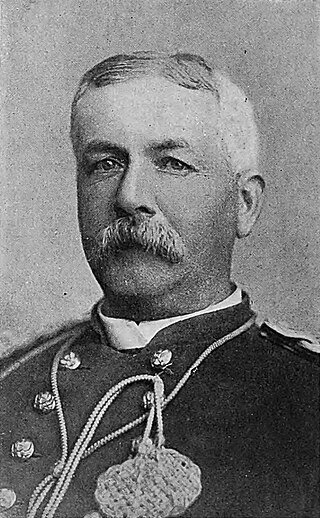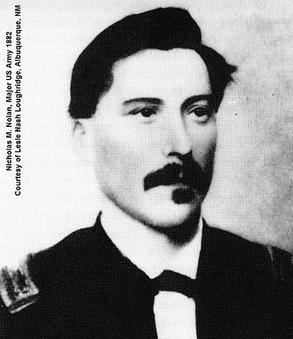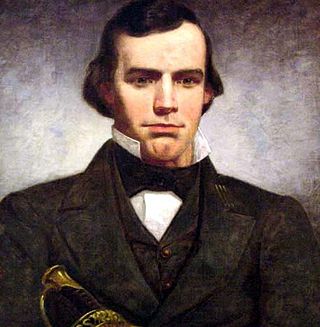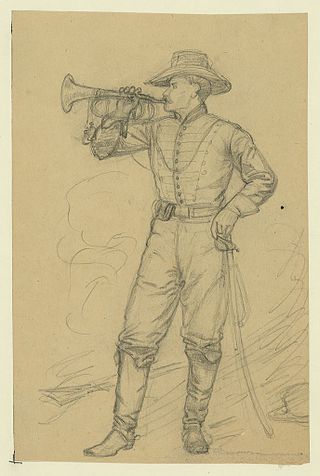
The Battle of Aldie took place on June 17, 1863, in Loudoun County, Virginia, as part of the Gettysburg Campaign of the American Civil War.

Theophilus Francis Rodenbough was born in Easton, Pennsylvania and was a Union Army officer during the American Civil War. He received America's highest military decoration the Medal of Honor for his actions at the Battle of Trevilian Station. After his retirement from the U.S. Army in 1870, he wrote several books about military history.

The Los Angeles National Cemetery is a United States National Cemetery in the Sawtelle unincorporated community of the West Los Angeles neighborhood in Los Angeles County, California.

The 1st West Virginia Cavalry Regiment served in the Union Army during the American Civil War. Although it started slowly, it became one of the most active and effective of the West Virginia Civil War regiments—and had 14 Medal of Honor recipients, the most for any West Virginia regiment during the war. It was originally called the 1st Virginia Cavalry, not to be confused with the Confederate 1st Virginia Cavalry. Some reports added "Union," "Loyal" or "West" when identifying this regiment. After the Unionist state of West Virginia was officially admitted to the Union in 1863, the regiment became the 1st West Virginia Cavalry Regiment. The National Park Service identifies it as the 1st Regiment, West Virginia Cavalry.

Alfred B. Hilton was an African American Union Army soldier during the American Civil War and a recipient of America's highest military decoration—the Medal of Honor—for his actions at the Battle of Chaffin's Farm.

Samuel M. Whitside was a United States Cavalry officer who served from 1858 to 1902. He commanded at every level from company to department for 32 of his 43 years in service, including Army posts such a Camp Huachuca, Jefferson Barracks, and Fort Sam Houston, the Departments of Eastern Cuba and Santiago and Puerto Principe, Cuba, commanded a provisional cavalry brigade, a squadron in the 7th Cavalry Regiment, and a troop and platoon in the 6th Cavalry Regiment. The pinnacle of his career was serving as the commanding general of the Department of Eastern Cuba before retiring in June 1902 as a brigadier general in the U.S. Army.

The 5th Michigan Cavalry Regiment was a cavalry regiment that served in the Union Army during the American Civil War. It was a part of the famed Michigan Brigade, commanded for a time by Brigadier General George Armstrong Custer.

Abraham Kerns Arnold was a U.S. Cavalry officer during the American Civil War and, while a captain in the 5th U.S. Cavalry, received the Medal of Honor for leading "a gallant charge against a superior force of the enemy, extricated his command from a perilous position in which it had been ordered" against Confederate forces at Davenport Bridge, Virginia, on May 10, 1864.

Louis Henry Carpenter was a United States Army brigadier general and a recipient of the Medal of Honor for his actions in the American Indian Wars.

Nicholas Merritt Nolan was a United States Army major. An Irish immigrant, he began his military career in New York on December 9, 1852, with the 4th Artillery, and subsequently served in New York's 2nd Dragoons. He enlisted as a private and rose through the ranks becoming a first sergeant. He was commissioned an officer in late 1862 in the Regular Army, while serving with the 6th U.S. Cavalry Regiment during the American Civil War. He participated in 16 campaigns with the 6th and most of its battles. He was slightly wounded at the Battle of Fairfield and seriously wounded at the Battle of Dinwiddie Court House. He was brevetted twice and noted at least twice for gallantry during combat. He was slightly wounded when captured at the end of March 1865, and was later paroled. After the Civil War, he served with the 10th U.S. Cavalry, known as the Buffalo Soldiers, for 14 years. Nolan is also noted for his pluses and minuses during the Buffalo Soldier tragedy of 1877 that made headlines in the Eastern United States. He was the commanding officer of Henry O. Flipper in 1878, the first African American to graduate from the United States Military Academy at West Point. He commanded several frontier forts before his untimely death in 1883.

Ovila "Frenchy" Cayer was a Union Army soldier in the American Civil War and a recipient of the United States military's highest decoration, the Medal of Honor, for his actions at the Battle of Globe Tavern.

John Quincy Marr was a Virginia militia company captain and the first Confederate soldier killed by a Union soldier in combat during the American Civil War. Marr was killed at the Battle of Fairfax Court House in Fairfax, Virginia, on June 1, 1861. Previously one of Fauquier County's two delegates to the Virginia Secession Convention of 1861, Marr initially opposed his state's secession from the Union but ultimately supported secession, as did voters shortly before his fatal skirmish.
The 22nd New York Cavalry Regiment was a cavalry regiment of the Union Army during the American Civil War.

Edward Washburn Whitaker (1841–1922) was a Union Army officer during the American Civil War. He was awarded the Medal of Honor for gallantry in action in 1864. He was the youngest general in the Union Army, promoted to Brigadier General at the age of 23.

Edward Parsons Tobie Jr. was a United States soldier who received his nation's highest award for bravery during combat, the U.S. Medal of Honor, while fighting with the Union Army during the American Civil War as a sergeant-major with the 1st Maine Volunteer Cavalry. According to his Medal of Honor citation, despite having been severely wounded during the Battle of Sailor's Creek, Virginia on April 6, 1865, and again at Farmville on April 7, he refused hospitalization, choosing instead to remain with his regiment in order to perform the duties of the 1st Maine's regimental adjutant who had recently fallen in combat. Those duties included services rendered by Tobie at Appomattox.

Ferdinand Frederick Rohm was a native of the German Kingdom of Württemberg who fought for the federal government of the United States during the American Civil War. He was awarded America's highest honor for valor, the U.S. Medal of Honor, for his gallantry while fighting with the Union Army as the chief bugler for the 16th Pennsylvania Cavalry during the Second Battle of Ream's Station, Virginia on August 25, 1864. As his regiment retreated under heavy enemy fire that day, he "remained behind to succor a wounded officer who was in great danger, secured assistance, and removed the officer to a place of safety." Rohm was then also severely wounded in action less than a year later as his regiment fought at Farmville, Virginia on April 7, 1865 during the war-ending Appomattox Campaign.

The 5th New York Cavalry Regiment, also known as the 5th Regiment New York Volunteer Cavalry and nicknamed the "1st Ira Harris Guards", was a cavalry regiment of the Union Army during the American Civil War. The regiment had a good fighting reputation, and had important roles in the Battle of Hanover and the Battle of the Wilderness. It was present at nearly 175 battles and skirmishes, including Gettysburg, Opequon, and Cedar Creek. A majority of its fighting was in Virginia.
Edwin F. Savacool was a captain in the United States Army who was awarded the Presidential Medal of Honor for gallantry during the American Civil War. He was awarded the medal on April 24, 1865, for actions performed at the Battle of Sailor's Creek in Virginia on April 6, 1865.

William Badger Tibbits was an officer in the Union Army during the American Civil War. He raised a company of infantry in the 2nd New York Infantry, and led it as captain, and later major, till 1863, when he was authorized to raise and lead a regiment of cavalry, the 21st New York Cavalry, and was promoted to colonel. On January 13, 1866, President Andrew Johnson nominated Tibbits for appointment to the grade of brigadier general of volunteers, to rank from October 18, 1865, and the United States Senate confirmed the appointment on February 23, 1866. On May 4, 1866, President Johnson nominated Tibbits for appointment to the grade of brevet major general of volunteers to rank from March 13, 1865, and the United States Senate confirmed the appointment on May 16, 1866.

Edgar Pierpont Putnam was an American businessman and civic leader in Jamestown, New York. As a young man, he served in the Union Army cavalry during the American Civil War, advancing from private to captain and ultimately receiving the Medal of Honor for his actions as a sergeant leading a scouting party on the day before the 1864 Battle of Totopotomoy Creek in Virginia.


















